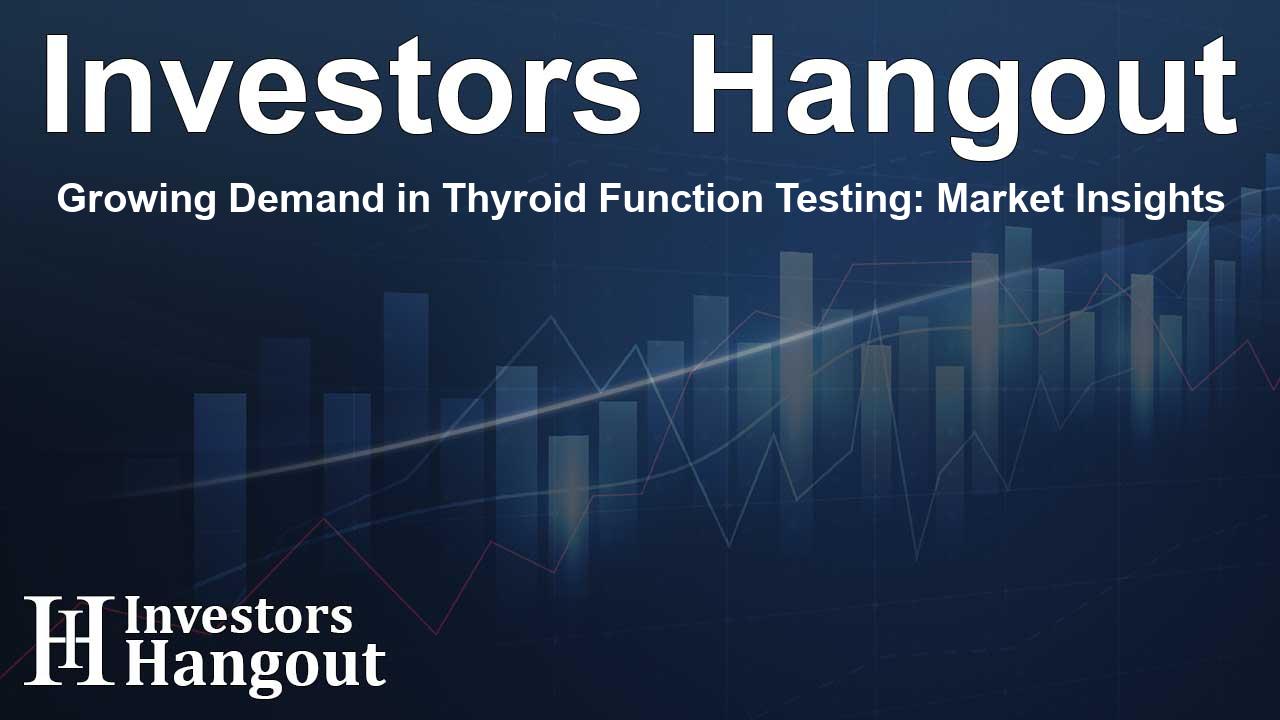Growing Demand in Thyroid Function Testing: Market Insights

An In-Depth Look at the Thyroid Function Test Market Growth
The Thyroid Function Test Market is entering a phase of robust growth, poised to reach USD 7,289.26 million by 2032, reflecting a substantial compound annual growth rate (CAGR) of 6.31%. This expanding market can be attributed to several pivotal factors affecting the global healthcare landscape.
Understanding the Drivers of Market Growth
Thyroid disorders are increasingly prevalent worldwide, escalating the demand for accurate and accessible testing solutions. Key hormones evaluated in these tests include Thyroid-Stimulating Hormone (TSH), Thyroxine (T4), and Triiodothyronine (T3). The significance of regular thyroid function tests is undeniable as they play a crucial role in diagnosing conditions like hypothyroidism and hyperthyroidism.
The Importance of Regular Checking
With more individuals becoming aware of the symptoms associated with thyroid dysfunction—such as fatigue and mood fluctuations—healthcare providers are noting a rise in proactive screening initiatives. Many countries have implemented public health campaigns boosting awareness surrounding thyroid health. Additionally, routine health screenings often include thyroid function tests, enhancing the detection rates of previously undiagnosed cases.
Key Factors Propelling Market Dynamics
A combination of rising disorder prevalence, public awareness, and advancements in technology is propelling the Thyroid Function Test Market forward. The automation of laboratory processes has significantly increased the speed and accuracy of tests, catering to the growing demand from healthcare providers seeking reliable diagnostic solutions.
Technological Advancements Reshaping Testing
The integration of new technologies, such as Point-of-Care (POC) testing devices, is revolutionizing access to thyroid function tests. These devices allow healthcare professionals to perform tests in various settings, enhancing convenience for patients who may not have easy access to traditional laboratory facilities. Furthermore, improved diagnostic technologies enable more efficient data collection and processing, leading to quicker, more precise results.
Market Challenges and Barriers
Despite the promising growth trends, the Thyroid Function Test Market is not without its challenges. High costs associated with advanced testing methods can be prohibitive, especially in developing nations where healthcare resources are often strained. Additionally, inconsistent reimbursement policies may deter healthcare practitioners from opting for comprehensive testing services, limiting patient access.
A Need for Greater Accessibility
Addressing the barriers present in the healthcare ecosystem, particularly in resource-limited areas, is vital for maximizing market potential. As awareness continues to grow, efforts to educate both patients and providers about the availability and importance of testing will be essential.
Future Market Landscape and Opportunities
Looking ahead, the future of the Thyroid Function Test Market appears bright, driven by growing healthcare infrastructure in emerging markets. Companies that strategically position themselves within these regions, proactively addressing local needs, stand to benefit significantly.
Consumer-Driven Testing Solutions
The rise of Direct-to-Consumer (DTC) testing approaches is another notable trend within the market. As consumers increasingly seek control over their health, platforms enabling individuals to perform thyroid testing from home are gaining traction. This movement not only empowers patients but also fosters greater engagement in managing chronic health conditions.
Concluding Thoughts on the Thyroid Function Market Dynamics
In conclusion, the Thyroid Function Test Market is on the cusp of substantial growth, reflecting broader trends in health consciousness and technological enablement. By addressing potential barriers and harnessing technological advancements, stakeholders can navigate and leverage the intricacies of this evolving market.
Frequently Asked Questions
What is the projected value of the Thyroid Function Test Market by 2032?
The Thyroid Function Test Market is expected to reach USD 7,289.26 million by 2032.
What are the primary factors driving market growth?
Key growth drivers include the rising prevalence of thyroid disorders, increased public awareness, and advancements in test technologies.
How does awareness affect testing rates?
Increased awareness leads to higher screening rates as individuals recognize the symptoms of thyroid dysfunction and seek evaluation.
What challenges are faced in expanding access to testing?
High testing costs and inconsistent insurance reimbursements are significant barriers, particularly in developing regions.
What trends indicate the future direction of the market?
Emerging trends such as Direct-to-Consumer testing and advancements in POC technologies are set to shape the market's growth trajectory.
About The Author
Contact Olivia Taylor privately here. Or send an email with ATTN: Olivia Taylor as the subject to contact@investorshangout.com.
About Investors Hangout
Investors Hangout is a leading online stock forum for financial discussion and learning, offering a wide range of free tools and resources. It draws in traders of all levels, who exchange market knowledge, investigate trading tactics, and keep an eye on industry developments in real time. Featuring financial articles, stock message boards, quotes, charts, company profiles, and live news updates. Through cooperative learning and a wealth of informational resources, it helps users from novices creating their first portfolios to experts honing their techniques. Join Investors Hangout today: https://investorshangout.com/
The content of this article is based on factual, publicly available information and does not represent legal, financial, or investment advice. Investors Hangout does not offer financial advice, and the author is not a licensed financial advisor. Consult a qualified advisor before making any financial or investment decisions based on this article. This article should not be considered advice to purchase, sell, or hold any securities or other investments. If any of the material provided here is inaccurate, please contact us for corrections.
